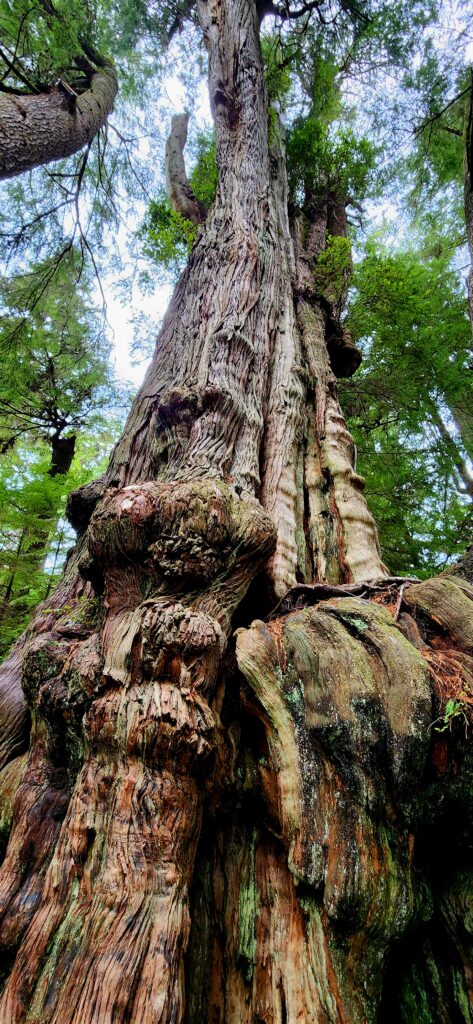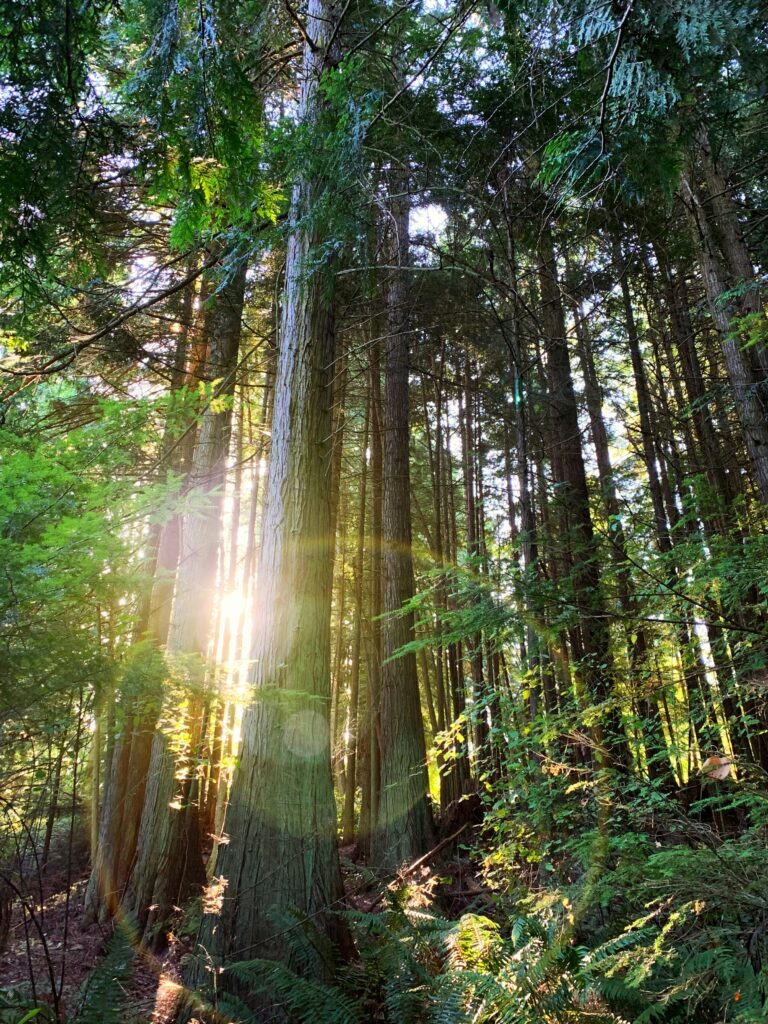BOTANICAL PROFILE: WESTERN RED CEDAR (Thuja plicata)
Classification
Family: Cupressaceae (Cypress family)
Genus: Thuja
Species: plicata
Common Names: Western Red Cedar, Giant Arborvitae, Pacific Red Cedar, Shinglewood
Theophrastus, a student of Aristotle’s, gave the name Thujato a tree with fragrant, resinous wood. Plicata refers to the folded nature of the tree’s scale-like leaves. – Oregon Encyclopedia
Habitat and Range
Native to the Pacific Northwest of North America, ranging from Southeast Alaska through British Columbia, Washington, Oregon, and into Northern California and parts of Montana. The Western Red Cedar thrives in moist, coastal forests and riparian zones, often growing alongside Douglas-fir and Western Hemlock.
Description
Cedar’s drooping branches do more than create shade. They intercept rainfall, helping slow down runoff and protect the forest floor from erosion. This gentle regulation of water supports stream health and keeps the surrounding soil stable and moist.
This cycle of life, death, and regeneration is part of what makes cedar forests so rich and diverse.
The Western Red Cedar is a natural sanctuary. Birds nest high in its branches. Owls and bats roost in the hollows of old trunks. Squirrels, raccoons, and insects take shelter in the deep crevices of its bark. And when a cedar eventually falls, it doesn’t stop giving—its decaying trunk becomes a nurse log, hosting mosses, fungi, ferns, and even new seedlings.
In essence, the Western Red Cedar isn’t just a tree—it’s a keystone species in many forest ecosystems. It anchors the ecological web by nurturing life above and below the soil, stabilizing the land, regulating moisture, and storing carbon. Its presence signals a healthy, mature, and complex forest environment.



Ecological Role
With reddish-brown, fibrous, and stringy—easy to peel in long strips which is often used in weaving by indigenous people. The leaves are scale-like and aromatic when crushed, arranged in flat sprays. It has small, woody, and rosebud-shaped cones.
A coniferous evergreen, it can live for over 1,000 years and grow more than 200 feet tall.
Even in the heat of summer, step beneath a cedar and you’ll often feel a pocket of cool, damp air. That’s no accident—Western Red Cedars help maintain humidity and create microclimates that shelter sensitive plants, amphibians, and mosses.
Cedar trees give back to the earth in a quiet, steady way. Their leaves and bark decompose slowly, enriching the soil with organic material over time. Their deep root systems help hold hillsides and riverbanks together, preventing landslides and erosion.
And beneath the soil, cedars are part of a vast mycorrhizal network—a web of fungal partnerships that helps trees share water and nutrients across the forest. It’s a hidden underground world where cooperation, not competition, keeps the forest strong.
One of cedar’s most impressive roles is its ability to lock away carbon. These trees can live for centuries—some over a thousand years—and their wood resists rot long after they’ve fallen. This makes the Western Red Cedar a natural carbon bank, helping offset the impacts of climate change.
Spiritual and Indigenous Significance
The Tree of Life
For many Pacific Northwest Indigenous tribes, including the Coast Salish, Tlingit, Haida, Tsimshian, and Kwakwaka’wakw, the Western Red Cedar is often referred to as the “Tree of Life”—a provider of shelter, tools, clothing, medicine, and spiritual connection. Canoes were carved from large trunks, some capable of holding over 20 people. Totem poles and longhouses were constructed from its wood. Bark was woven into clothing, ropes, and ceremonial regalia. Leaves and bark were used for medicinal teas, inhalants, and smudging.
Ceremonial Role
Cedar was (and is) burned in purification rituals, akin to sage in other traditions. It is laid on hot stones in sweat lodges to cleanse and invite spiritual presence. Fresh boughs are used to line floors or are brushed against the body for spiritual cleansing.
“Cedar is sacred—it carries our prayers to the spirit world.”
coast salish elder
The Western Red Cedar is more than a tree—it’s a keystone species, a forest guardian, and a quiet ally in the climate fight. Every time we walk beneath its boughs or run our hands along its fibrous bark, we’re touching something ancient, wise, and vital.
So next time you find yourself in a cedar grove, pause. Breathe in that distinct, earthy aroma. Listen to the rustle of its branches. Feel the softness of its shade.
You’re in the presence of something sacred—and deeply ecological.


Leave a Reply